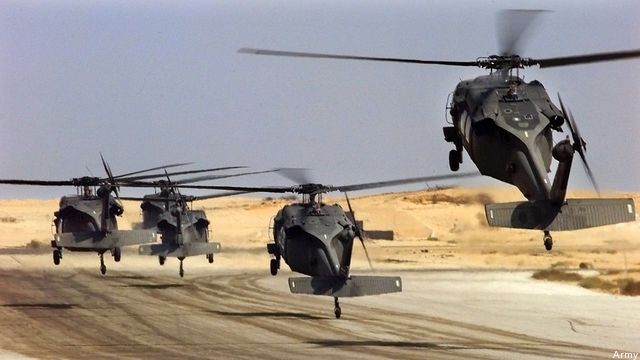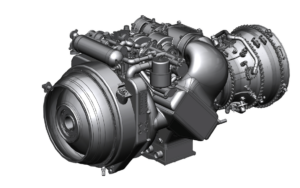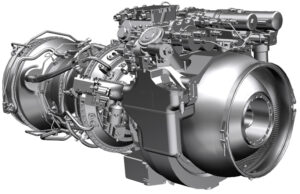
With the Association of the US Army’s annual conference starting Monday, there is no better time for an analysis of the top modernization program for Army aviation. And we’ve got one of the top experts on helicopters providing the commentary, Mike Hirschberg of the American Helicopter Society International.
Should the Army plow ahead with an engine upgrade for the Apache and Black Hawk helicopters or should it skip ahead to the Future Vertical Lift effort? Read on. The Editor.
Last week’s article by Richard Whittle about the Army’s Improved Turbine Engine Program (ITEP) and the Army’s Strategic Portfolio Analysis and Review (SPAR) was wrong on one very important point.
The final quote in the story — by an anonymous “retired senior Army aviation officer” — says that if the SPAR decides to accelerate the Future Vertical Lift (FVL) program, “then ITEP will not make any sense at all.”
This is just plain wrong.
What’s ITEP?
During the conflicts in Afghanistan and Iraq, both the Army’s UH-60 Black Hawk and the AH-64 Apache helicopters suffered significant issues due to the power and efficiency limitations of the current T700 engine: neither aircraft was able to reach the higher altitudes — particularly at higher temperatures — that the conflicts often demanded, sometimes with tragic consequences.

ATEC HPW3000 ITEP engine concept
Since the YUH-60A and YAH-64A prototypes first flew as the Vietnam War was ending, the T700 power has increased by 25%, to 2,000 shaft horsepower today. But this has not kept pace with the growth in weight and drag of the two twin-engine helicopters over the past 40 years, and both aircraft are likely to continue in service for another three to four decades. A mid-life engine upgrade such as ITEP is sorely needed.
ITEP is a leap ahead in engine technology to provide a new lease on life for the Apache and Black Hawk. Compared to the T700, it will provide 50% more power, a 65% improvement in power-to-weight, a 20% longer engine life, a 25% improvement in specific fuel consumption, and 20-25% lower production and maintenance costs.
ITEP is considered the Army’s number one aviation modernization priority. Although it’s taken much too long to get to this point, the difficult technical and budgetary challenges have been overcome and the program now is on track to complete engine qualification and begin production in 2024.
What’s FVL?
The joint Department of Defense FVL program is an ambitious plan to replace all of the current US military rotorcraft over the next 40-50 years. The first aircraft that DoD is planning to develop — with the unfortunate moniker of “FVL Capability Set 3” — is currently expected to replace the Black Hawk and Apache, as well as potentially other DoD missions.
The FVL acquisition program officially begins in fiscal 2017 with a Materiel Development Decision (MDD), initiating an Analysis of Alternatives. This is expected to lead to the selection of an aircraft for Engineering and Manufacturing Development (EMD) in late 2023. Low rate initial production is expected to begin in 2029.
The Science & Technology initiative to support the FVL program is the Joint Multi-Role (JMR) Technology Development effort. The Bell Helicopter V-280 Valor tiltrotor and the Sikorsky-Boeing SB>1 Defiant compound are both largely industry-funded, intended to show the best that the American helicopter industry is capable with today’s state of the art. Both high-speed demonstrators will fly next year. (Karem Aircraft and AVX Aircraft are also conducting high-speed demonstrator studies and conducting component demonstrations.)
The aircraft envisioned under FVL are truly revolutionary, and industry is leaning forward, willing to develop and produce them in a revolutionary manner as well. Both Bell Helicopter and Sikorsky-Boeing have stated that if the concepts that they are demonstrating as part of JMR were selected for FVL CapSet 3, they could shave years off of the development timeline. Both company teams have clearly demonstrated their rapid prototyping capabilities and most likely could move the start date of EMD three years to the left to 2020 — and the start of production sooner than 2029 — if the US government could also streamline its processes.
So, if FVL is going to replace the Black Hawk and Apache, why do they need a new engine?
The retired officer quoted in Whittle’s article suggests that the cost of ITEP could be avoided if the Apaches and Black Hawks are replaced sooner. This is an incredible oversimplification. As mentioned, under current plans, the first FVL CapSet 3 rotorcraft would begin production in 2029. With more than 2,000 Black Hawks and nearly 1,000 Apaches to be replaced, it would take decades to build enough FVL CapSet 3 aircraft: “It would probably take us 30 years to replace all the Black Hawks in the fleet,” Richard Kretzschmar, project manager for ITEP and the Army-led FVL both, is quoted in the article.
But, for the sake of argument, let’s look at the most optimistic case. Let’s say that DoD was able to work with industry, through the Vertical Lift Consortium, for example, and fundamentally changed the way that the Pentagon developed and acquired the first FVL aircraft. What if EMD could start in four years (2020) and production began in 10 years (2026)?
Let’s assume that beginning Day One, industry was able to build 125 aircraft per year (the peak combined annual production of the Black Hawk and Apache after 30 years of production learning). It would take 24 years to produce 3,000 aircraft, meaning the last FVL CapSet 3 rotorcraft would roll off the assembly line in 2050, allowing the last Apache and Black Hawk to be retired around that time.
Again, all of these are quite optimistic assumptions. Current Pentagon plans indicate the Apache/Black Hawk sunset date would be a decade or more later.
So, in the “best case” scenario, Apaches and Black Hawks will be flying for only 34 more years; “worst case,” more likely, they will still be flying 50 years from now.
ITEP – Gotta Have It

General Electric GE3000 ITEP engine concept
Apaches and Black Hawks were used to perform incredible deeds during the conflicts in Afghanistan and Iraq, despite their performance shortfalls. Many lives were lost in crashes due to insufficient power at high/hot conditions. Both aircraft have only gotten heavier over the decades and the trend will doubtlessly continue. Having underpowered, fuel hungry aircraft as the mainstay of the military’s rotorcraft fleet for the next 40-50 years is simply not acceptable — not to the Army and not to the American people. ITEP will save lives.
ITEP will permit missions that simply cannot be executed today — particularly at high altitude and hot temperatures — at far less cost in terms of fuel, maintenance, manpower and risk.
With much longer range, UH-60s and AH-64s can also avoid frequent refueling stops, putting fewer soldiers in harm’s way. We owe it to our men and women in uniform to finish developing this next generation engine and give the Apache and Black Hawk decades of continued superior performance.
Mike Hirschberg is Executive Director of the American Helicopter Society (AHS) International, the non-profit vertical flight technical society.
In a ‘world first,’ DARPA project demonstrates AI dogfighting in real jet
“The potential for machine learning in aviation, whether military or civil, is enormous,” said Air Force Col. James Valpiani. “And these fundamental questions of how do we do it, how do we do it safely, how do we train them, are the questions that we are trying to get after.”


























